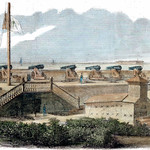 Born in Scotland, James Chester was an artillery sergeant at Fort Sumter when Confederate forces fired on the fort in April 1861 in the opening hostile exchange of the American Civil War. A career soldier, Chester was breveted as a second lieutenant in April 1863 and eventually reached the rank of major during his 44-year service.
Born in Scotland, James Chester was an artillery sergeant at Fort Sumter when Confederate forces fired on the fort in April 1861 in the opening hostile exchange of the American Civil War. A career soldier, Chester was breveted as a second lieutenant in April 1863 and eventually reached the rank of major during his 44-year service.
Chester authored:
- First Scenes of the Civil War (1), The United Service. A Monthly Review of Military and Naval Affairs, May 1884, covering Fort Moultrie, the evacuation, and life at Fort Sumter
- First Scenes of the Civil War (2), The United Service. A Monthly Review of Military and Naval Affairs, June 1884, covering Fort Sumter, preparing for defense, bombardment, ceasefire, and aftermath. (While published, this is an interim version. The text is mostly complete. Additional proofing and clarification is needed as well as more illustrations.)
- Inside Sumter in ’61, an essay in Battles and Leaders of the Civil War, edited by Clarence Clough Buel and Robert Underwood Johnson, Vol. 1. New York, NY: The Century Co., 1887.
Chester’s service:
- Battery E, 1st U.S. Artillery Regiment, December 1, 1854-April 17, 1863, private, corporal, sergeant, and first sergeant
- 1854-1856, Fort Monroe, Virginia
- 1856-1857, campaign against Florida Indians
- 1858-1860, Fort Moultrie, South Carolina
- 1861, Defense of Fort Sumter
- 1861-1862, Shenandoah Valley and Peninsular campaigns; commanded an artillery section at battles of Glendale, Malvern Hill, and Second Bull Run, Va., Antietam, Md. and Fredericksburg, Va.
- April 17, 1863, Brevet Second Lieutenant, 1st U.S. Artillery Regiment
- commanded battery at Chancellorsville; Va. commanded artillery section at Aldie, Middletown, Upperville, Va.
- July 3, 1863, Brevet First Lieutenant, U.S. Army
- Gettysburg, Pa., Shepherdstown, Va.
- Monument on the battlefield to Barreries E. & G.:
“July 3 One section under Lieut. James Chester was ordered to Second Brigade Third Cavalry Division and took position west of the Low Dutch Road and with Brig. General Custer’s Second Brigade Third Division Cavalry Corps was hotly engaged in repelling the attack of Major General Stuart’s Confederate Cavalry Division. The one section under Lieut. Ernest L. Kinney remained near the Hanover Road.
- Acting Assistant Adjutant General, 2nd Horse Artillery Brigade
- Major General P. Sheridan’s campaigns with Army of the Potomac and Shenandoah Valley, Va.
- August 25, 1864, Brevet Captain, U.S. Army
- Wounded at Kearneysville, Va.
- January 14, 1865, First Lieutenant
- September 1865, Joined company at Raleigh, NC
- October 20, to December 14, 1865, Aide-de-Camp to General Hardin
- December 1865 – April 1867, Acting Assistant Inspector General, Military Command of North Carolina
- Other roles and places:
- post adjutant, acting assistant quartermaster, and assistant commissary subsistence at Hilton Head, S. C.
- commanded battery at Ft. Pulaski, Ga.
- U. S. Artillery School
- commanded battery at Charleston, S. C.
- Ft Hamilton, N. Y.
- Military science professor at Iowa State University
- Assistant engineering instructor at U. S. Artillery School, Fort Monroe, Va.
- Engineering instructor at U. S. Artillery School
- Aide-de-Camp to Brevet Maj. Gen. G. Gotty
- June 7, 1897, Major
- February 10, 1898, retired
- Died, May 27, 1903, Washington, D.C.
- A 3-gun coastal gun battery at Fort Miley, San Francisco County, California, was named after Major James Chester